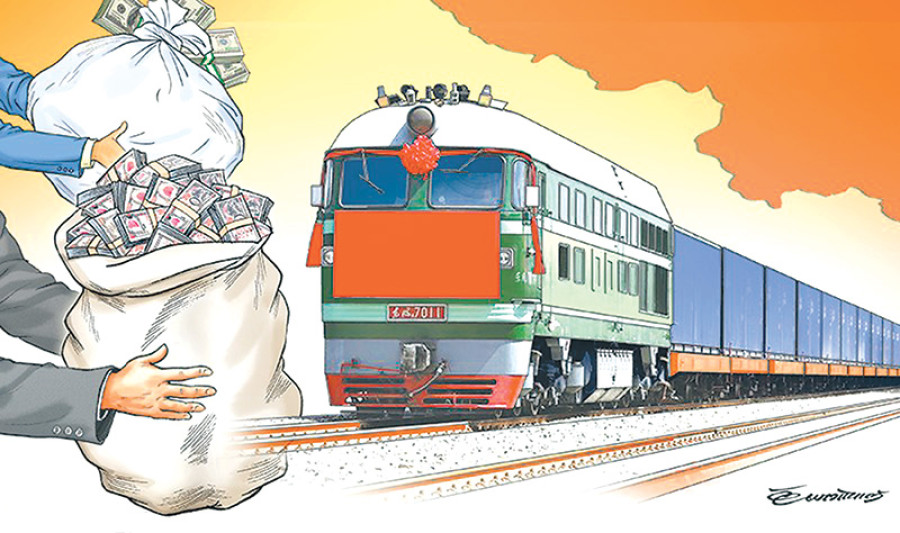Opinion
Fast lane ahead
The investments made in transport infrastructure will benefit generations to come
Gao Liang
During Prime Minister Oli’s first visit to China in March 2016, the two countries reached a series of agreements including permitting Nepal to use Chinese ports for trading. At that time, Nepal was recovering from the nightmare of a ‘blockade’ by a neighbouring country and hoping to avoid a similar situation in the future by diversifying its trade. Earlier this month, Nepal and China finalised the protocol to the Transit and Transport Agreement (TTA), thereby gaining the right to use several Chinese seaports and land ports. Despite difficulties in bring this agreement into full function for these two countries, which are closely linked geographically, politically and culturally, this is an important and historic progress in building a strategic channel. Landlocked Nepal has more choices in foreign trade. Given time and confidence, the TTA will become a game changer in regional cooperation.
There is a widely circulated saying in China that building a road is the first step to becoming rich. There is a consensus in the whole country to attach great importance to the construction of transportation infrastructure, and this is also integrated into its foreign policy. As early as the 1970s, when China’s economic and technological development had not reached today’s level, it assisted the building of the 1,860-km Tan-Zam Railway connecting Tanzania and Zambia. Nearly half a century later, connectivity of facilities is still the most important part of China’s Belt and Road Initiative (BRI). Transportation-based connectivity will provide a material basis for policy coordination, unimpeded trade, financial integration and people-to-people bonds. The final completion of the TTA has created a favourable policy environment for the further improvement of the connectivity of transportation facilities between China and Nepal.
Far-reaching implications
Take a look at the map of China, and one will easily understand the far-reaching implications of the four seaports and land ports that the TTA has allowed Nepal to use. Tianjin port is the largest comprehensive seaport in northern China and is oriented towards East and Northeast Asia. It is also an important inland transportation hub. Lian Yun Gang is located on the Yangtze River Delta in eastern China, facing Japan. This port is the starting point of the trunk transportation line linking China’s eastern and western parts, and also the starting point of the eastern section of the New Silk Road (the ‘Road’ in the BRI). Shenzhen and Zhanjiang ports are located on the Pearl River Delta in southern China. They are the main gateways for China’s foreign trade. Shenzhen and Hong Kong are separated by just a river.
Hainan Province, which faces Zhanjiang port across a narrow strait, is a free trade zone. Ships setting sail from these two ports can easily connect Southeast Asia and regions beyond. The three land ports, Lanzhou, Lhasa and Shigatse, have already been comprehensively linked by rail and road networks. The proposed Sino-Nepal railway will also be constructed starting from Shigatse. Lanzhou is the most important transportation hub connecting north-western China with Xinjiang and Central Asia. In 2016, China began operating a South Asian freight train from Lanzhou via Shigatse to Kathmandu. Currently, a railway from Chengdu, the economic centre of south-western China, to Lhasa is under construction. By 2026, this new fast passage to Tibet will be completed.
What Nepal has gained by signing the TTA is access to a large and advanced logistics network that supports the rapid development of the Chinese economy. With the steady enhancement of bilateral cooperation between the two countries, we can boldly expect that more Chinese ports will be opened to Nepal in the future. More importantly, the network connectivity of China-Nepal transportation facilities will not only play a role in transit transportation, but also in bilateral trade, personnel exchanges and political relations.
Mongolia, Kazakhstan and other neighbouring countries have also signed similar agreements with China. As a beneficiary and promoter of globalisation, China is fully expanding its relationship with the developing countries and emerging markets. Amid the growing risk of a trade war, the only solution seems to be a diversified foreign trade which can be achieved by increasing the total volume of trade and improving the quality of trade. Nepal is an indispensable partner of China in bringing the BRI into reality. With the finalisation of the agreement and improved facilities, Nepal will become involved in the broader international market through China. In return, China will also find more opportunities with Nepal acting as a bridge to the rest of South Asia
Reducing the costs
As far as the specific implementation of the agreement is concerned, what we have to consider is how to reduce the costs and further facilitate it. The shortest distance between Kathmandu and the four Chinese seaports is more than 1,000 km. A long distance generally means more cost. The limited road transport capacity from Kathmandu to the Sino-Nepali border ports is the most realistic and urgent issue facing both countries. China’s 216 and 318 national highways leading to Kerung and Khasa (Tatopani) ports are in good condition and have sufficient capacity. In the future, there will be more room for improvement after they are upgraded. Once the proposed Sino-Nepal railway is completed, cross-border transportation will be greatly facilitated. Therefore, we are once again returning to the topic that has been discussed again and again: Transform, upgrade and build more transportation facilities from both sides to the Sino-Nepali border.
The most crucial part in solving these problems is breaking through the limitations of concepts. How to choose between short- and long-term interests is something worth thinking about. A country’s strategic channel is what its people will use for generations. Governments will change and every generation will pass away, but the country’s geographical location will never move. The significance and advantages of the TTA may not be fully apparent in the short term, but this should not be the reason for it to remain on paper. If we are farsighted and determined to reach the destination, no one can deny the necessity of taking the difficult first step. Then we will be confident that the investment and construction related to this is not only for the present, but more for the future.
Liang is a doctoral student at Sichuan University, China




 14.12°C Kathmandu
14.12°C Kathmandu










